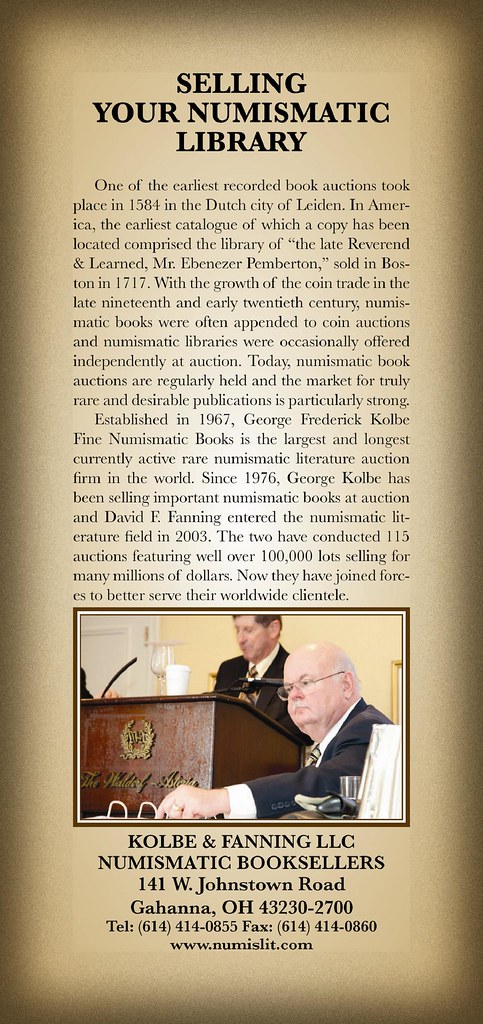
About UsThe Numismatic Bibliomania Society is a non-profit organization promoting numismatic literature. For more information please see our web site at coinbooks.org SubscriptionsThose wishing to become new E-Sylum subscribers (or wishing to Unsubscribe) can go to the following web page link MembershipThere is a membership application available on the web site Membership Application To join, print the application and return it with your check to the address printed on the application. Membership is only $15 to addresses in the U.S., $20 for First Class mail, and $25 elsewhere. For those without web access, write to: David M. Sundman, Secretary/TreasurerNumismatic Bibliomania
Society AsylumFor Asylum mailing address changes and other membership questions, contact David at this email address: dsundman@LittletonCoin.com SubmissionsTo submit items for publication in The E-Sylum, just Reply to this message, or write to the Editor at this address: whomren@coinlibrary.com
BUY THE BOOK BEFORE THE COINYou won't regret it! |
- WAYNE'S WORDS: THE E-SYLUM MAY 2, 2010
- SKLOW LITERATURE AUCTION SALE #10 CATALOG AVAILABLE
- BOOK REVIEW: GOLD IN HIS VEINS: THE STORY OF JOHN DAGGETT
- MINT NOSTALGIA PRESERVED THROUGH HISTORICAL TIMBER
- THE 2010 NUMISMATIC LITERATURE SUMMER SEMINAR CLASS
- U.S. MINT ENGRAVER CHARLES BARBER'S ENGRAVING TOOLS
- NOTES FROM E-SYLUM READERS: MAY 2, 2010
- THE WORLD'S LARGEST BANKNOTES
- MORE ON THE 1942/41 OVERDATE DIMES
- ASHMOLEAN MUSEUM'S HEBERDEN COIN ROOM REOPENS
- ON PAPER MONEY REPAIRS
- JEFFREY LAPLANTE ON COIN CABINETS
- BRUCE LORICH ON COIN DEALER ROBERT BATCHELDER
- THE BROOKGREEN GARDENS MEDAL'S NUMISMATIC CONNECTION
- MORE ON THE BROOKGREEN GARDENS MEDAL SERIES
- SPREADING POLITICAL SENTIMENTS VIA BANKNOTES
- CURATOR'S COMMENTS ON THE ANS COUNTERFEIT MONEY EXHIBIT
- BOOK: SMASHERS: PHOTOGRAPHS OF VICTORIAN COUNTERFEITERS
- QUERY: FARMERS ALMANAC ARTICLE ON FRASER'S INDIAN MODELS
- CANADIAN PARLIAMENT STUDIES ABOLISHING CENT COIN
- FUZZY WUZZY ANGEL MEDALS
- QUICK QUIZ: WHO IS THE MYSTERY NUMISMATIST?
- NUMISMATICS MEETS TWITTER
- WHEN MONEY IS JUST AN ILLUSION
- NEW YORK TIMES ARTICLE COMPARING THE OLD AND NEW $100S
- MAN CAUGHT PAYING COUNTY FINE WITH COUNTERFEIT NOTE
- FEATURED WEB SITE: THE E-SYLUM ARCHIVE
WAYNE'S WORDS: THE E-SYLUM MAY 2, 2010

Among our new subscribers this week are Tim Shisler, courtesy of Jeff Marsh and Eduardo Capocchi. Welcome aboard! We now have 1,336 subscribers.
Sorry I missed the EAC convention last week in Annapolis. Jim Neiswinter and others were asking for me. I was hoping to attend the Friday dinner and Joel Orosz and Len Augsburger's talk afterwards about their new book.
Fate intervened and I ended up not going. I was unable to get a reservation for the dinner, and other plans didn't work out. I hear it was a great convention and hope E-Sylum readers in attendance had a good time.
This week we open with notes from two Davids: David Sklow updates us on his latest literature sale, and David Lange treats us to a book review. Next up are notes from Len Augsburger and Joel Orosz on research for their upcoming book on Frank Stewart and the first Philadelphia Mint.
Other topics this week include the world's largest banknotes, political sentiments on banknotes, counterfeiting and counterfeiters, dealer Robert Batchelder, the Brookgreen Gardens medal series, and a new numismatic quiz.
To learn about numismatics and Falun Gong, the Shubert distillery, Charles Barber's engraving tools, Da Ming Tong Xing Bao Chao, the scaffold-scaling 93-year-old, Colombian drug dealers, and the Fuzzy Wuzzy Angels of Australia, read on. Have a great week, everyone!
Wayne Homren
Numismatic Bibliomania Society
SKLOW LITERATURE AUCTION SALE #10 CATALOG AVAILABLE
 On June 12, 2010, David Sklow-Fine Numismatic Books will close their 10th auction. Catalogs available by request at no charge; Send inquiries to:
On June 12, 2010, David Sklow-Fine Numismatic Books will close their 10th auction. Catalogs available by request at no charge; Send inquiries to:
David Sklow-Fine Numismatic Books, P. O. Box 6321, Colorado Springs, CO 80934. Telephone: (719)-302-5686; Fax: (719)-302-4933; Email: numismaticbooks@aol.com.
The catalog is currently accessible on-line: www.finenumismaticbooks.com . Bids will be accepted by, telephone, fax, email and regular mail.
BOOK REVIEW: GOLD IN HIS VEINS: THE STORY OF JOHN DAGGETT
Mint Master, Lieutenant Governor & More
by Richard G. Kelly & Nancy Y. Oliver
(reviewed by David W. Lange)
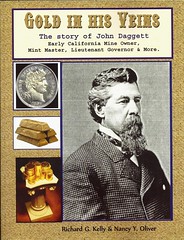 Rich Kelly and Nancy Oliver have become well established as the premier researchers of San Francisco Mint history, and the latest fruit of their labor is a fascinating book about the life of a person known to numismatists mostly for the wrong reason. It has long been assumed that John Daggett was the primary person responsible for the creation of a United States numismatic rarity–the 1894-S dime.
Rich Kelly and Nancy Oliver have become well established as the premier researchers of San Francisco Mint history, and the latest fruit of their labor is a fascinating book about the life of a person known to numismatists mostly for the wrong reason. It has long been assumed that John Daggett was the primary person responsible for the creation of a United States numismatic rarity–the 1894-S dime.
In addition to chronicling his entire life from birth to death, Kelly and Oliver have provided compelling evidence that Daggett, superintendent of the San Francisco Mint 1894-97, played only a peripheral role in the creation of these coins, though he may have been aware of their rarity at some point. This is just one chapter in the many which relate the rich life of a California pioneer who came west in '52 to seek his fortune. Like many prosperous individuals of the Gilded Age, he was part gentleman and part scoundrel, in addition to being a devoted family man.
In their Introduction the co-authors state that their purpose in writing this book was several-fold: It is a continuation of their ongoing research into the 1894-S dimes; it relates to their long-held fascination with the San Francisco Mint; it complements their interest in genealogy; and, finally, it completes a task which Daggett himself sought to undertake but did not live long enough to do–write his own memoirs.
This book relates John Daggett's New York State upbringing as the son of a foundry owner and his attempts to establish a similar business in California during the Gold Rush 1850s. After middling success as a prospector, John and his brother David did establish a foundry in Marysville, California, but the business was cut short by his brother's untimely death. John ultimately began to dabble in mine ownership himself, and this is where he built the wealth that sustained him and his family for the remainder of his life. It also permitted him to dabble in California politics, where he held several state offices though failed in his attempt to become a United States senator.
A lifelong Democrat, Daggett's prospects were challenging in the post-Civil War America, which was dominated by the Grand Old Party. He still held some sway in California, and this permitted him to be named superintendent of the San Francisco Mint in 1894 during the Democratic administration of President Grover Cleveland. His political enemies smeared Daggett for this appointment which, they claimed, was obtained through the influence of railroad tycoon Leland Stanford.
In all probability this was true, and Daggett set about replacing mint employees with loyal party Democrats. The openness with which this was done is astonishing to readers today, though it appears to have been the norm in a time when every position was held by political appointment. Daggett himself was terminated following the inauguration of Republican President William McKinley in 1897.
John Daggett was absent from the mint more than he was present during the first year and a half of his superintendence, and he drew much criticism for this neglect from his several political enemies. If he knew of the rare 1894-S dimes, no document penned by him has survived to confirm it. Kelly and Oliver relate what they've discovered about these rare coins in some detail.
What documents do exist seem to confirm that just 24 dimes were made June 9, 1894. This work was performed to complete an odd sum as part of a mandated melting and recoining of obsolete issues. The mint's employees almost certainly assumed that coinage of this denomination would continue during the second half of 1894, with thousands or millions of coins resulting, but this never came to pass. As early as 1895 the San Francisco Mint's officers and clerks were replying to inquiries about this rare issue and advising the correspondents to seek out dealers in rare coins.
The years following his removal from the San Francisco Mint were primarily ones of retirement, though John Daggett's story was far from over. He died in 1919 at the age of 86, having lived a full and occasionally controversial life. The entire span of his life is revealed in detail through this book. Rich Kelly and Nancy Oliver drew upon a broad range of sources to tell his life story, and their book is filled with a great many documents, letters, advertisements and personal reminiscences which tell the full story of John Daggett, his family and his acquaintances. There are quite a few intriguing sidebar stories that provide a rich image of Victorian Era California in general and the mining industry in particular. Absolutely no one will be disappointed in the text of this book.
If there is any criticism to be made it is in the book's production values. Like previous works by this writing team it does have a certain homemade quality to it. The photos and other images are clearly multi-generational copies and are sometimes quite indistinct. Of course, this is true of the surviving source material itself in some instances, so the fault is not always theirs.
The book is perfect bound, and it would have benefited from a scoring line on both front and back to permit easier reading and provide greater durability to the cover. Though its price reflects the low production cost of this book, I would have preferred to pay more for a volume that appears more graphically pleasing. I believe the subject matter is sufficiently interesting to warrant the added expense. Nevertheless, I would not let this stand in the way of adding this title to one's library.
Gold in His Veins is available from O.K. Associates, 26746 Contessa Street, Hayward, CA 94545. It is priced at $21.95, postpaid. Emails may be directed to: noliver146@sbcglobal.net.
To read the earlier E-Sylum article, see: NEW BOOK: GOLD IN HIS VEINS: THE STORY OF JOHN DAGGETT (www.coinbooks.org/esylum_v13n13a04.html)
MINT NOSTALGIA PRESERVED THROUGH HISTORICAL TIMBER
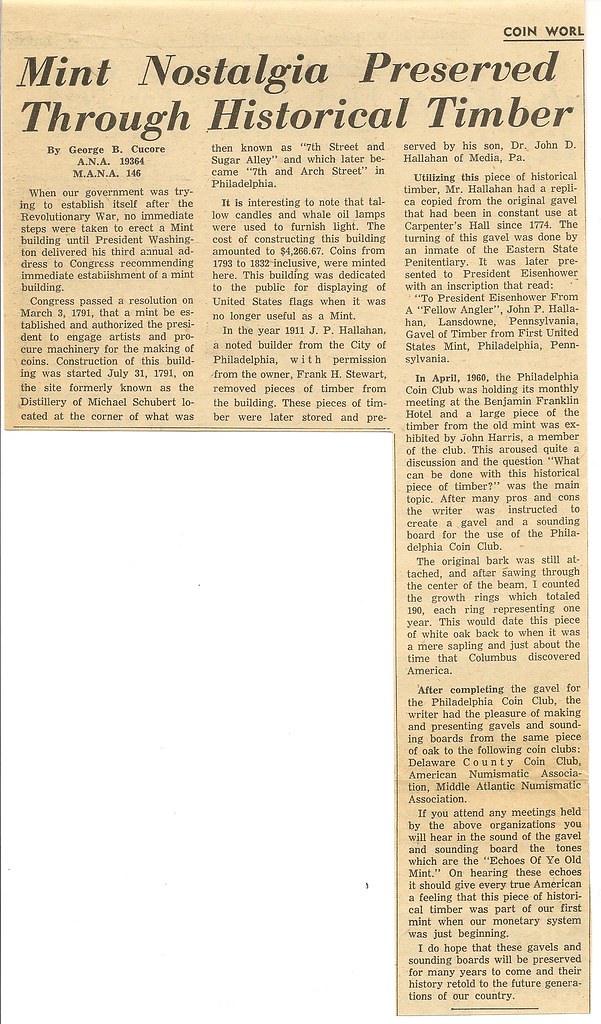
Copyright 1962 by Amos Hobby Publishing Inc. Reprinted by permission from the Dec. 7, 1962, issue of Coin World, Sidney, OH. www.coinworld.com
Len Augsburger writes:
This is very, very useful and fills in a lot of holes left by other sources. Thanks so much! I had a Coin World article from 1960 on the same subject, but didn't know about this one. Cucore did some of the actual work on the timber, so to get it directly from him only strengthens the information. This will make that section of the book a lot more authoritative.
Joel Orosz adds these annotations:
1. The act authorizing the Mint was passed by Congress on April 2, 1792. Construction did not begin on July 31, 1791, as stated in the article, but rather on July 18, 1792.
2. The Shubert distillery was indeed located on North Seventh Street, and one of the three lots that comprised it also fronted on Sugar Alley. However, the building actually located at the corner of North Seventh and Sugar Alley (No. 35 North Seventh) was never owned or even rented by the Mint.
3. The notion that the corner of North Seventh and Sugar Alley later became the corner of North Seventh and Arch Street is novel, but wrong--these were two different intersections, separated by half a block. The past tense is used advisedly here, for the North Seventh and Sugar Alley intersection today is buried under the Green Federal Building.
4. Coins dated 1793 to 1832 were indeed minted here, but also a few dated 1833, during January of that year.
5. If the timber had 190 growth rings, the tree from which it came began growing approximately in 1602, 110 years after Columbus's first voyage to the New World--hardly "just about the time that Columbus discovered America." It was five years before the English settlement at Jamestown--still pretty impressive.
Len adds:
I wrote up a piece for the PCGS US coin forum a few months ago on the same subject --
forums.collectors.com/messageview.cfm?catid=26
&threadid=755196&highlight_key=y&keyword1=mint&keyword2=timber
.
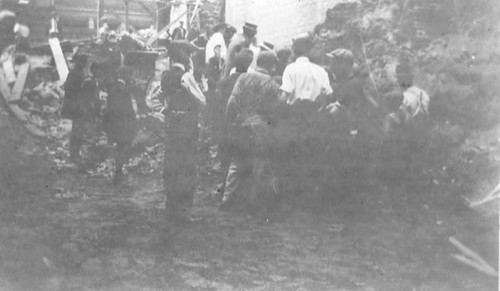
This excerpt discusses artifacts constructed from first mint timber. There are many other artifacts as well, and these will be discussed in the book.
To set the stage, is it the year 1911 in Philadelphia and Frank H. Stewart has decided to finish the razing of the first mint buildings in order to expand his business (located on the next lot) into the former mint space. We pick up the action as the final razing of the first mint campus is in progress:
Modern construction sites in the big city are liberally draped in protective plywood curtains, but a hundred years ago it was not so, and certainly not at 37 and 39 North Seventh Street in Philadelphia. Stewart's demolition was wide open to the public, who were free to wander the site in search of treasure. Stewart thought enough to capture a photo for posterity. “People from off street at noon time - digging for relics,” he wrote on the reverse. To this pictorial record Stewart added the following commentary:
“Every noontime, while the workmen were eating their luncheon, a crowd of boys would search the dirt for relics, and the finds made by these boys will unquestionably be saved by them. Scores of pieces of iron, brick, stone and wood were taken away and curiosity was unhampered to the fullest extent.”
THE 2010 NUMISMATIC LITERATURE SUMMER SEMINAR CLASS
 Numismatic books, catalogs and periodicals
have long been an essential tool of researchers
and collectors—both beginner and expert.
These printed tools also are collectibles in
their own right.
Numismatic books, catalogs and periodicals
have long been an essential tool of researchers
and collectors—both beginner and expert.
These printed tools also are collectibles in
their own right.
Explore the different types of references, touching on their usefulness, availability and hidden secrets. Learn what constitutes a personal library and how to maintain it, build it and successfully use it.
The course also will touch on proper handling, storage and shipping of numismatic literature. A tour of the ANA Library is included.
Instructor: David Sklow, cataloger, owner and operator www.finenumismaticbooks.com
This 2-day class will be offered the following dates and times:
- Monday and Tuesday, June 28-29, 9 AM-4 PM (class #5)
- Wednesday and Thursday, June 30-July 1, 9 AM-4 PM (class #6)
- Monday and Tuesday, July 5-6, 9 AM-4 PM (class #41)
- Wednesday and Thursday, July 7-8, 9 AM-4 PM (class #42)
Summer Seminar registration fees vary depending upon tuition and lodging preferences.
For a complete course catalog go to: www.money.org
Questions? Call 719-482-984
U.S. MINT ENGRAVER CHARLES BARBER'S ENGRAVING TOOLS
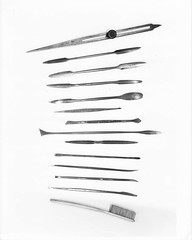
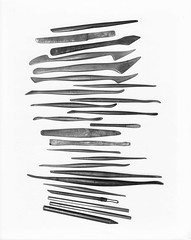
Lots 44 and 45 in the upcoming Kolbe & Fanning sale of the second part of the Stack Family Library of numismatic literature (closing June 3) consist of two photographs (one set in each lot) depicting Charles Barber's engraving tools. The well-executed photographs show the very tools with which Barber did his engraving work for the U.S. Mint, and depict the tools at or about their actual size. These tools were also owned by the Stack Family and were donated along with the originals of the Barber Papers to the Smithsonian.
THE BOOK BAZARRE
NOTES FROM E-SYLUM READERS: MAY 2, 2010
Regarding last week's E-Sylum, Dave Bowers writes:
My gosh, what a nifty “issue”!
Tom DeLorey writes:
Bill Burd's Chicago Coin Company IS in Chicago! It simply is not in downtown Chicago. This city just goes on and on and on......
Paul Hybert echos Tom's note:
Bill Burd's storefront shop is in the Chicago city limits even though it is far from downtown. We have a big town here.
Better late than never, two numismatic museum curators took the BBC News Numismatic Quiz. -Editor
Dick Doty of the National Numismatic Collection at the Smithsonian Institution writes:
I missed the last one too, got the other six right.
Douglas Mudd, Curator of the American Numismatic Association's Edward C. Rochette Money Museum writes:
Darn – 6 out of 7 – I just do not know my Adam Smith well enough and have not looked that closely at modern British bank notes. I wonder if the Brits missed the West Point question as much as we Americans seem to have missed #7?
To read the earlier E-Sylum article, see: WHO PASSED THE BBC NEWS NUMISMATIC QUIZ? (www.coinbooks.org/esylum_v13n17a16.html)
An E-Sylum reader writes:
The Numismatic Bibliomania Society got some publicity from The Numismatist in the latest issue (May), This month's quiz involves scrambled words from titles of numismatic organizations, the NBS being one of them.
I found the quiz somewhat harder than I expected, although I didn't take them up on the instructions to look at the list of organizations on their website. (That would seem to remove any possible fun from the exercise.)
THE WORLD'S LARGEST BANKNOTES
Pete Smith writes:
The answer to your query about the largest banknote would be the Philippines 100,000 peso note of 1998. I only claim single credit. I would not have known this without a web search.
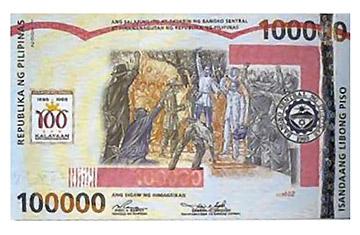
Measuring in at roughly the size of a sheet of legal paper, the world's largest single banknote is the 100,000-peso note created by the government of the Philippines in 1998. Designed to celebrate a century of independence from Spanish rule, the note was offered only to collectors, who could purchase one of the limited-edition notes for 180,000 pesos, or about $3,700.
Pete adds:
I am somewhat skeptical that there was not something larger in the dim past. The Chinese had a note called Da Ming Tong Xing Bao Chao described as 34 cm by 22 cm. I figure that is a little shorter but slightly wider than the Philippines note.
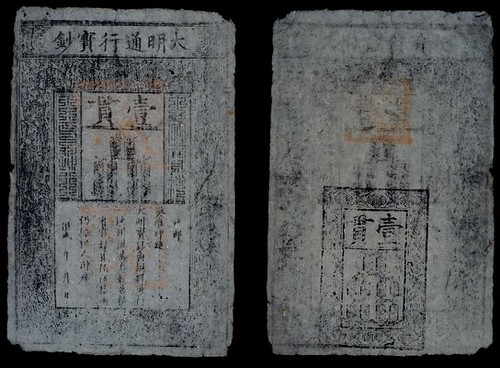
To read the complete article, see:
Top 10 Things You Didn't Know About Money
(www.time.com/time/specials/packages/article
/0,28804,1914560_1914558,00.html)
MORE ON THE 1942/41 OVERDATE DIMES
Regarding the recent discussion on whether the 1942/41 overdate dimes are actually doubled dies, John Dannreuther writes:
I believe the best term for the 1942/1 dimes is "dual-hub overdate."
These are two individual working dies that were left over from 1941 and were rehubbed with the 1942 hub. Prior overdates had only the date area affected, while these two dies had impressions from a 1941 and a 1942 hub, which had the dates on the hub. Thus, some have called these dual hub issues "double dies." Technically, they are, but as Tom Delorey pointed out, nothing is doubled but parts of the date. The 1916 double die nickel has offset impressions from a single 1916-dated hub, thus is a true double die.
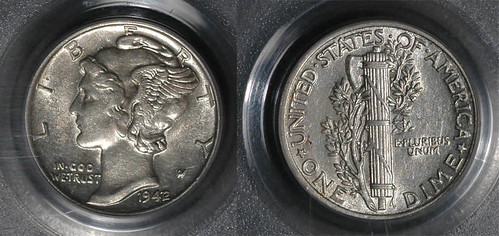
To read the earlier E-Sylum article, see: THE 1942/41 OVERDATE DIMES: NOT DOUBLED DIES (www.coinbooks.org/esylum_v13n17a15.html)
ASHMOLEAN MUSEUM'S HEBERDEN COIN ROOM REOPENS
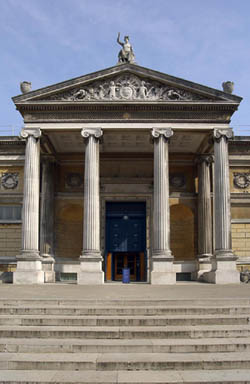 On Thursday this week, I attended the opening of the Heberden Coin Room at the Ashmolean Museum in Oxford. There have been several openings for the museum, but this was an event for the numismatists, and there were a very large number of us present. Many had not seen the new Money Gallery, which is a new addition to the museum. Previously there was only a tiny display area outside the study room, where one used to view the coins.
On Thursday this week, I attended the opening of the Heberden Coin Room at the Ashmolean Museum in Oxford. There have been several openings for the museum, but this was an event for the numismatists, and there were a very large number of us present. Many had not seen the new Money Gallery, which is a new addition to the museum. Previously there was only a tiny display area outside the study room, where one used to view the coins.
Apart from the new gallery, coins are integrated in many of the galleries within their cultural or economic context. The old displays were set up to aid teaching, with different cultures, types of objects, or periods were grouped together. The new concept, under which the display is organized, is called “Crossing Cultures, Crossing Times”, which sets different objects from very different cultures alongside each other.
I spent a lot of time in the Ashmolean when I was a student in Oxford, but most undergraduates never set foot in it. As there are such amazing treasures in all these old Oxford museums, it always seemed a great shame that few saw them. The other museums were even more old-fashioned, which added for me to their attraction. In the Pitts River Museum, which holds truly amazing anthropological collections, the old cases were so dark that visitors were given flash lights to view shrunken heads, baskets, photographs or whatever one would suddenly recognize in a case.
The Ashmolean Museum was a little less dramatic to visit, but these museums were a strong influence on me to pursue museum work and not academic teaching. Now, the original idea of the Ashmolean Museum, which was Britain's - and probably the world's - first public museum, has been revived: the aim is to bring everyone into a modern museum, and it seems to be working. There are visitors everywhere, and many of them children.
The new study room for the Heberden Coin Room is a large room, adjacent to the new coin vault. Most importantly, it has large windows, which allows researchers and students to look at objects in daylight. If there is one, major problem, it is the lack of a reference library.
The amazing numismatic library, which used to be part of the Heberden Coin Room, was moved into the Sackler Library as part of the research library for archaeology, art history, and classics. Luckily, the Keeper, Christopher Howgego, has been able to begin rebuilding the reference library. Thanks to some generous donors, there are some of the standard works on the mostly empty shelves.
The opening itself was a great event for me to connect with old friends from Britain and abroad, who had travelled to Oxford to attend the event. The reception and a small dinner were very generously sponsored by Classical Numismatic Group, which was represented by their principals Victor England and Eric McFadden as well as their London-based staff.
The website of the Ashmolean Museum is at http://www.ashmolean.org/, and you can help the museum by voting for it at the website of the Art fund. The winning museum will win £100,000 (around $160,000)
To visit the Ashmolean web site, see: www.ashmolean.org
To vote, go to: The Art Fund Prize (www.artfundprize.org.uk/2010/vote/)
THE BOOK BAZARRE
ON PAPER MONEY REPAIRS
Tony Hine writes:
In reply to an inquiry about repairs to banknotes, I think it is timely to explain that coins should only be cleaned using Photoshop on scans of the uncleaned coins, and I expect any serious paper money collector would give the same advice for banknotes!
David Gladfelter writes:
One can get on a high horse about this topic, because there are abuses.
Now that the Garden State Parkway is no longer going to accept tokens at its toll booths, how many of us are cashing in our rolls and part rolls of the tokens and how many of us are putting them aside in our box of traders?
My guess would be that the savers are in the majority, because that's our nature. We collect tokens, medals, scrip and other forms of exonumia not only for our own enjoyment, but to preserve them for others to enjoy in the future. Not only do we save them, but we care for them as well. If the supply is large, we might pick out the best ones to save and spend the rest. If the ones we save are dirty or cruddy, we might wipe them carefully or clean them gently. We might take a goat-hair brush to a copper piece to bring up the lustre or patina. Almost everyone would moisten and straighten a corner fold on an old note. That's “conservation,” the protection and preservation of our exonumic history.
But what about filling up or patching over a hole in a token or note? What about retooling or re-engraving a damage spot? This would offend the purist who would leave a less-than-perfect piece strictly alone, but would not bother the fixer-upper who would try to improve its appearance. I have seen examples of rare notes that have been put together piece by piece from parts of different damaged notes; I even own one or two with such “prosthetics” but have not created any. You might call this “restoration,” or bringing something back to a former or improved condition.
The point is, there's a gradient here, like the biologist's definition of what constitutes the soil. Bacteria? Sure. Earthworms? Maybe, there's no hard and fast rule. Well, woodchucks? Where does one draw the line?
Let's look at a case in point. Shown above is a full size image of a rare but ugly looking New Jersey colonial bill of credit that once belonged to me, a 15 shilling bill from the October 20, 1758 issue with plate letter A (below the crowns at bottom center) and serial number 17710. This bill, when I owned it, was split down the middle and taped together on back with opaque tape. It had tape residue on the corners and a lot of dirt overall. Eventually I got a better one and sold this one to a well known dealer.
Shortly afterward, in one of his auctions, I saw a bill that looked vaguely familiar. Comparing it with the foregoing image, I saw that it was the same bill but by now it had undergone restoration. In the process, the plate letter had been removed, the serial number changed to 15710 and the signatures retraced. It was now graded “very fine or better” with “some corner repairs” but there was no mention of the restoration or the former split. Its spruced-up image, taken from the dealer's web site (enlarged) is shown below.
How far should one go with restoration? Did this dealer cross the line? In our hobby at this time, there's no right or wrong answer to this question. All but the least ethical among us would agree that “whizzing” is a no-no, but short of that, what's permissible? In your opinion, is the “new identity for A-17710” legit?
My own view, for what it's worth, is as follows:
1. “Restoration” should not be confused with “conservation,” and should not be described as “conservation.” (The grading services, when they mention it at all, use the term “conservation” to mean “restoration.”)
2. Any “restoration” that is done to a piece of exonumia should require full disclosure.
3. Full disclosure should include mention of any and all significant defects (such as the split in our subject bill) that were originally present in the item and that have been repaired.
4. Never, under any circumstances, should anything be altered. Alteration includes such things as retracing signatures and making changes to plate letters, serial numbers or other identifying marks (either inadvertently or deliberately).
5. A restored item should not be graded higher than its pre-restoration condition.
If we can adopt safeguards such as these, no one will be misled. Then, being fully informed, it will be up to the individual collector whether or not to acquire the item in question.
To read the earlier E-Sylum article, see: QUERY: PAPER MONEY REPAIRS (www.coinbooks.org/esylum_v13n17a18.html)
JEFFREY LAPLANTE ON COIN CABINETS
I had read The History of United States Coinage as Illustrated by the Garrett Collection by Q. David Bowers, and in that book Bowers kept mentioning the cabinet. It kept coming up, over and over - the Howland Wood cabinet, the United States Mint cabinet, the Garrett cabinet. Then about a third of the way through the book there was a picture of Garrett's desk and the cabinets containing his coins. They were beautiful and then a few pages later Dave pictured an advertisement from about 1885 which had an illustration of a cabinet for sale.
I wanted one, and because I am a history nut (and coin nut) I thought it would be real cool to have a nice wooden cabinet to display my coins. So, I went off and searched like a madman to see if anyone still made these things and I could find nothing. I even looked up the company in Ohio who had the ad from the 1880s. That company was still in business making handmade wooden cases, but mainly for tools and they were very expensive. Very expensive is actually too mild, they were extraordinarily expensive.
Well, long story short and usually the way things happen, I am a longtime subscriber to The E-Sylum and there was an article on coin cabinets in that week's edition. Bingo. I sent an email to Craig MacDonald and eureka, so now I am the owner of beautifully made Cabinets by Craig original. It is stunning, the craftsmanship is exquisite, and I could not be happier.
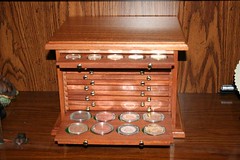
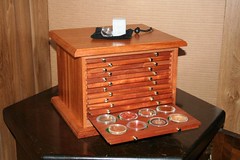
BRUCE LORICH ON COIN DEALER ROBERT BATCHELDER
Alan Weinberg wrote:
"Crew-cutted Bob Batchelder of Ambler PA, who almost invariably had the best and highest quality material at each NY show, was the first bourse dealer any serious collector would approach. He wasn't cheap and his prices made you swallow hard, but he had the "stuff" and a pleasant personality to boot. He left numismatics abruptly decades ago - I never knew why - and made a name for himself in the rare autograph business still in Ambler, passing away around at 80 only perhaps two yrs ago."
I found Alan Weinberg's review of the 1960s coin scene delightful. That was when I started out. Before I ever met Dave Bowers, who hired me to work for Bowers & Ruddy Galleries in 1974, I knew Robert Batchelder, because were both lived in suburban Philadelphia.
I remember his constant ad in The Numismatist, listing all the coins he wished to purchase. I never could afford much of what he stocked when I was young but he was always a gentleman, even to a kid like me staring at jewels in his case at coin shows. Years later I visited him at his bank office (he bought a bank building in Ambler, PA) and he still had some wonderful British Soho Mint coppers, which I purchased. He probably owned them for decades but when he stopped dealing in coins he simply put them away.
Weinberg mentioned that he never knew why Batchelder left the coin business. I think I can tell you why. Batchelder's wife was ill for many years, and her husband was a loving care giver. I believe he stopped doing coin shows, and went into the mail-order autographs business, so that he could always be near her. He was too much of a gentleman ever to explain his reasons to anyone. Robert Batchelder was one classy guy!
To read the earlier E-Sylum article, see: ALAN V. WEINBERG ON THE HOBBY IN THE 1960S (www.coinbooks.org/esylum_v13n16a22.html)
THE BROOKGREEN GARDENS MEDAL'S NUMISMATIC CONNECTION
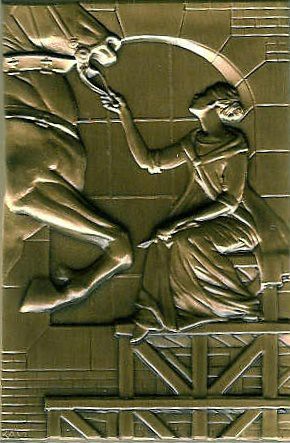

While the sculptor shown on this year's Brookgreen Garden Membership Medal, as illustrated in last week's E-Sylum, can be considered a tribute to any female sculptor, it is tacit admiration of the founder of Brookgreen Gardens itself, Anna Hyatt Huntington.
While in her nineties, she was still spry enough to climb scaffolding. She died at age 93 and had only stopped climbing ladders two years prior, while still creating heroic models in her Bethel, Connecticut, studio.
I like to tell the story that as early as 1912 she was earning more than $50,000 a year as a sculptor and was listed in "Who's Who in America" before her husband, Archer Milton Huntington was listed as a philanthropist.
Recognize the names? They each were benefactors of the American Numismatic Society. Archer not only donated the land at 155th & Broadway called Audubon Terrace, where the ANS was formerly headquartered, he also donated money for the building and underwrote purchases for their collections. The society's move away from Audubon Terrace to lower Manhattan, however, has greatly diminished the Huntington's numismatic luster. Anna Hyatt's most famous work is the heroic statue Joan of Arc, shown on the medal. The statue dominates the courtyard at Audubon Terrace.
A saying about Archer Milton Huntington: "Everywhere he put his foot down a museum sprung up!" This holds true not only for Brookgreen Gardens, but also for the six organizations at Audubon Terrace. This included Museum of the American Indian (now gone), American Geographical Society (now gone), American Hispanic Society (one of Archer's favorite museums, still there) and two others. He also founded the Mariners' Museum in Newport News, Virginia.
I also like to relate that Anna Hyatt Huntington's entry in "Who Was Who in American Art" (3 volumes by Peter Hastings Falk) is one of the longest -- for men or women -- surpassed only by the Peale Family artists.
To read the earlier E-Sylum article, see: THE 2010 BROOKGREEN GARDENS MEMBERSHIP MEDAL (www.coinbooks.org/esylum_v13n17a19.html)
MORE ON THE BROOKGREEN GARDENS MEDAL SERIES
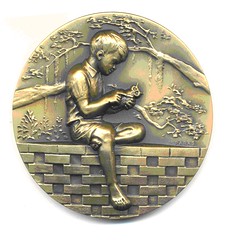 Offered here is a sizeable run of highly artistic medals emanating from Brookgreen Gardens, of Murrels Inlet, South Carolina, just south of Myrtle Beach. Everyone who has visited this sculptural garden becomes enthralled, as one views the sculptures, the flora and fauna there, and been captivated by the birds and animals in a natural habitat of outdoor splendor found here on the grounds.
Offered here is a sizeable run of highly artistic medals emanating from Brookgreen Gardens, of Murrels Inlet, South Carolina, just south of Myrtle Beach. Everyone who has visited this sculptural garden becomes enthralled, as one views the sculptures, the flora and fauna there, and been captivated by the birds and animals in a natural habitat of outdoor splendor found here on the grounds.
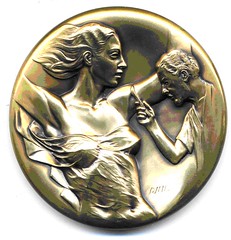 Numismatists will recognize dozens of names among the 350 sculptors' work here, most in outdoor garden setting, smaller pieces inside -- no surprise coin and medal artists also created large size sculpture. The founders of these gardens are also well known to numismatists. Archer Milton Huntington, benefactor of the American Numismatic Society in NYC, and his sculptor-medallist wife, Anna Hyatt Huntington, created this property in 1931 by acquiring four tracts of adjacent lands. They began installing sculpture and it opened to the public in 1937.
Numismatists will recognize dozens of names among the 350 sculptors' work here, most in outdoor garden setting, smaller pieces inside -- no surprise coin and medal artists also created large size sculpture. The founders of these gardens are also well known to numismatists. Archer Milton Huntington, benefactor of the American Numismatic Society in NYC, and his sculptor-medallist wife, Anna Hyatt Huntington, created this property in 1931 by acquiring four tracts of adjacent lands. They began installing sculpture and it opened to the public in 1937.
The series of yearly medals is somewhat of an afterthought. In 1945 animal sculptor Gertrude Lathrop had created a medal for Brookgreen Gardens, and later, in 1973 the sculptor-president of the Gardens, Carl Paul Jennewein, felt obligated to create a similar 3-inch medal, but this bore the conjoined portraits of the Huntingtons, and the Fighting Stallions, somewhat of a symbol for the Gardens, a massive bronze located at the Gardens entrance, created by Anna Hyatt herself.
 With the inspiration of these two medals it was for a later president, Joseph Veach Noble – who would concurrently become the executive director of The Society of Medalists – to install a medal program. His concept was brilliant. Bestow a medal to every member of Brookgreen Gardens. Membership was increased to $250 a year but this tied the medals to the wonderful variety of the Gardens collections, an appropriate icon for every member. Noble commissioned the sculptors who had sculpture on the site while still alive to prepare miniature sculpture to be issued in medallic form, or to established medallists who someday may have their sculpture here.
With the inspiration of these two medals it was for a later president, Joseph Veach Noble – who would concurrently become the executive director of The Society of Medalists – to install a medal program. His concept was brilliant. Bestow a medal to every member of Brookgreen Gardens. Membership was increased to $250 a year but this tied the medals to the wonderful variety of the Gardens collections, an appropriate icon for every member. Noble commissioned the sculptors who had sculpture on the site while still alive to prepare miniature sculpture to be issued in medallic form, or to established medallists who someday may have their sculpture here.
SPREADING POLITICAL SENTIMENTS VIA BANKNOTES
Philip Mernick writes:
Seeing the Featured Web Page on bank notes of Ghana reminded me that when I visited Ghana in 1985, I was told that putting a double fold in a note so the top read BANANA instead of BANK OF GHANA was considered anti-government propaganda and could lead to your arrest.
And in the news, followers of Falun Gong are putting their message on Chinese banknotes. -Editor
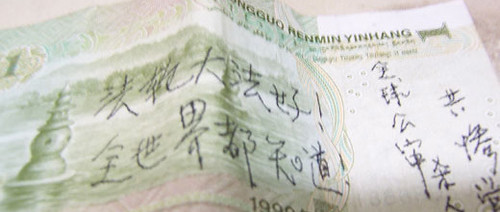
Falun Gong followers have entered the war of the banknotes.
For the Communist Party of China (CPC), the spiritual Falun Gong movement is a sect whose members must be actively sought out by the police. As a result, active participants have to find innovative ways to communicate their message without giving themselves away. Here are few examples of banknotes carrying the Falun Gong message:
To read the complete article, see:
The banknote revolt hits China
(observers.france24.com/en/content/20100428-banknote-
revolt-hits-china-falun-gong-cpc)
CURATOR'S COMMENTS ON THE ANS COUNTERFEIT MONEY EXHIBIT
ANS Fellow and ANA Chief Exhibit Judge Joe Boling clearly wasn't happy with the ANS and our new exhibition. He writes in the last E-Sylum:
"... the caption 'Bleached $100 note with fake watermark' is incorrect".
The whole purpose of bleaching banknote paper is to obtain a piece of paper that already has a genuine watermark in it - you don't need to insert another one. The Bureau changed the $5 note so that it would no longer bear a portrait watermark. If you are going to laminate a fake watermark into a note, you start with lightweight plain paper. Making it defeat the ubiquitous marker pens is not a problem."
I personally curated this exhibition, and I can assure Joe that the description was spot on. I didn't make it up myself, as all this material was given to me by U.S. Secret Service special agents, who deal with this on a daily basis.
In this particular case from Colombia, which is known as the "bleaching case", the counterfeiters bleached $1 notes with a rather primitive machine and graffiti removal spray. By doing this, the cotton-linen paper gets much thinner and the watermark is virtually gone. I inspected this myself by holding it up in the air.
They then print a yellowish face of Ben Franklin on one bleached note and printed the other side with a $100 design. A second bleached note has a fake glued (poorly done) security strip and the reverse design of the $100. Then the two notes are glued together in order to get the thicker paper of the original.
Is this logical? No, as the two notes come easily apart, but this is what these Colombian drug dealers were coming up with to make this work. And they produced a huge amount, as the photos of the seizure vividly show.

Bleached $100 note with fake watermark
IMAGE COPYRIGHT UNITED STATES SECRET SERVICE (USSS).
Go and see the exhibition, which has many more examples of counterfeit notes from 1867 to 2007. There is no need to book in advance. Most individual visitors just walk in off the street. They do not check tens of thousands of New York school children against the no-fly list- to stop this urban myth, but as there are hundreds of tons of gold in the basement, you cannot blame them for checking people.
Joe is however right about our mistake in the press release on the offset printing machines. Mea culpa - I didn't read the edited version carefully enough.
To read the earlier E-Sylum article, see: JOE BOLING ON THE ANS COUNTERFEIT MONEY EXHIBIT (www.coinbooks.org/esylum_v13n17a24.html)
BOOK: SMASHERS: PHOTOGRAPHS OF VICTORIAN COUNTERFEITERS
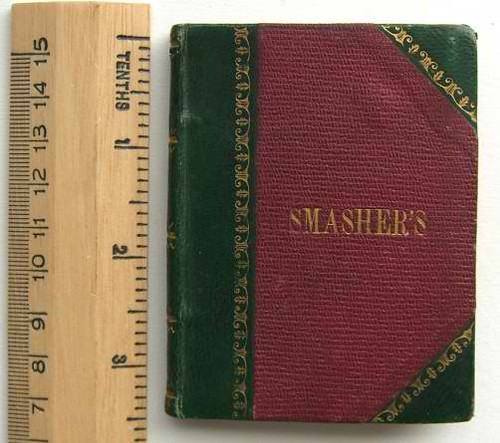
This English pocket photograph album, dating from around 1855-65, contains the identification portraits of eighteen known or suspected counterfeiters. 'Smashers', lettered in gilt on the front cover of the album, was a 19th century term, first recorded in 1811, for those who issued or passed counterfeit coinage or notes (Oxford English Dictionary).
The album, 90mm x 68mm in size, holds 18 albumen photograph vignette portraits, 14 of men, 4 of women, many in prison uniform. The first 11 portraits are sewn-in to the album as single images without backing and interleaved with blank paper; the final 7 portraits are cut and pasted on to blank bound-in pages at some period following binding. Although the final 7 photographs were added to the album after it was bound, and thus with the original 11 photographs already in place, stylistic evidence suggests they pre-date the images earlier in the album.
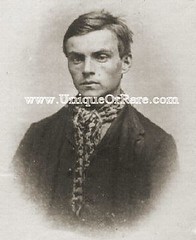
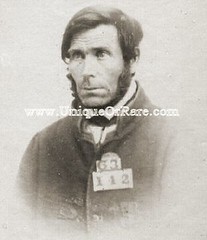
The origin and purpose of the album can only be a matter of conjecture. Prior to the early 1870s, criminals were photographed on an infrequent and casual basis, there being no official policy in force countrywide. In 1854, James Anthony Gardner, Governor of Bristol Gaol, had a photograph made of every prisoner in his charge and sent a copy to every prison in the country to obtain evidence of any earlier offences. His plan succeeded as certain men being treated by him as 'first offenders' were discovered to have held previous convictions elsewhere. In December of the same year, he issued a circular recommending the adoption of this plan at all British prisons.
To read the complete article, see: SMASHERS: Photographs of Victorian counterfeiters (www.uniqueorrare.com/uor-1934.htm)
QUERY: FARMERS ALMANAC ARTICLE ON FRASER'S INDIAN MODELS
David Lange writes:
Ginger Rapsus mentioned numismatic articles in The Old Farmers Almanac. Ten years ago or so that publication requested photos from my Buffalo Nickel book for an article about the Indian models used by James Earle Fraser. They promised to send me a copy of the published almanac with the photos but never did. Does anyone know whether the article and photos actually appeared?
To read the earlier E-Sylum article, see: NOTES FROM E-SYLUM READERS: APRIL 25, 2010 (www.coinbooks.org/esylum_v13n17a17.html)
CANADIAN PARLIAMENT STUDIES ABOLISHING CENT COIN
Conservative Irving Gerstein successfully proposed that the Senate national finance committee look at the usefulness and cost of the penny to Canadian taxpayers.
“Why do we need to study the penny?” asked Mr. Gerstein, who is a long-time fundraiser for the Conservative Party. “Many would argue the penny has simply outlived its purpose. It's a piece of currency which lacks currency.
“In fact, a penny cannot even buy a penny anymore. It costs far more than a cent to produce and distribute each penny.”
The Senator joked with his colleagues that this is “no ‘penny ante' issue.” However, he said he is not biased against the penny as there are merits to the coin and there are costs associated with getting rid of it.
Other countries, including Britain, Australia, New Zealand, Israel, Sweden, Norway and Demark, have gotten rid of their lowest currency denomination.

Dick Johnson adds:
The article is illustrated with a picture of a pile of cent coins. Interestingly enough, there appear several U.S. cents intermingled with Canadian. We assume they circulate side-by-side. Question for eagle-eyed E-Sylum readers: How many Lincoln cents can you find?
To read the complete article, see:
Senators give penny some thought
(www.theglobeandmail.com/news/politics/ottawa-notebook
/senators-give-penny-some-thought/article1549439/)
FUZZY WUZZY ANGEL MEDALS
Attached are pictures and quoted material from a ceremony I attended as a representative of the United States at the presentation of the first Commemorative Medallion to be given by the Government of Australia to a surviving member of WW II's Papua New Guinian Fuzzy-Wuzzy Angels on 23 July 2009.
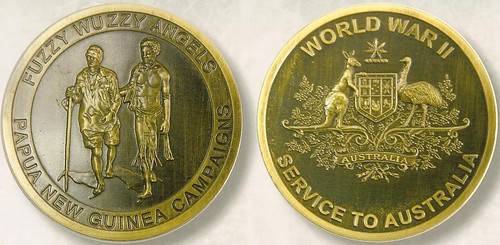
The fellow pictured, Nepe Kumanyal, and those who served with him were true heroes.
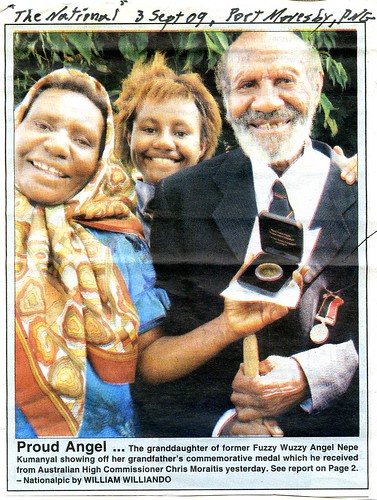
The medal given has, as far as I can tell, has received virtually no publicity outside of Papua New Guinea. After the ceremonies, I asked a representative from the Australian Department of Veteran Affairs if the medal would be made available for purchase by collectors. The answer was “No”. She did tell me 1500 medals (officially ‘medallions') had been minted by the Royal Australian Mint. The medals would be distributed to surviving Fuzzy-Wuzzy Angels, or if deceased, to surviving widows. No one else can or will get them.
A small blurb about the medal is available on the Australian Department of Veteran Affairs website, but it does not provide a picture, nor was it publicized in Australia.
From the 23 July 2009 presentation ceremony:
“Australians have long revered the Fuzzy Wuzzy Angels for their role in carrying supplies to troops fighting in nearly inaccessible terrain and for their care in evacuating the wounded,” Mr Griffin said. “Many Australians who became sick or wounded during the New Guinea campaign owe their lives to these civilians, who are affectionately known as Fuzzy Wuzzy Angels. They earned great respect for their strength, ingenuity and compassion. Their contribution is the basis of much of goodwill and warm relations between the two countries.”
The medallion was announced by (Australian) Prime Minister Kevin Rudd and (PNG) Prime Minister Sir Michael Somare on April 28. The medallion features the image of a blinded and barefoot Private George Whittington being helped along by Raphael Oimbari, which came from a photograph taken on Christmas Day 1942 near Buna on the PNG north coast. An estimated 50,000 Papuan and New Guinean citizens assisted during the Second World War by carrying supplies, building bases, airfields and other wartime infrastructure.
QUICK QUIZ: WHO IS THE MYSTERY NUMISMATIST?

THE BOOK BAZARRE
NUMISMATICS MEETS TWITTER
A new page was turned yesterday at a meeting of the Citizens Coin Advisory Committee.
Member Donald Scarinci sent out Tweets on Twitter as the meeting progressed. Since I was not in Philadelphia to attend the meeting, having on-the-spot commentary was both interesting and helpful.
I hope others feel this way and he will make Tweets a regular part of his role at CCAC.
Don told me that he started using Twitter just last week.
“This is probably numismatic history because it is the first time a CCAC meeting will be reported on Twitter,” he wrote me in an e-mail.
Naturally the primary purpose of the CCAC meeting was to choose a reverse design for the 2011 Native American dollar that it can recommend to the Treasury secretary, who makes the final decision. However, we might well remember it for the Tweets instead.
The CCAC endorsed a design that was also endorsed by the Commission of Fine Arts. It depicts a peace pipe being passed with just the pipe and the hands shown.
It marks the Wampanoag Treaty of 1621.
What I am really jealous of is not the Tweets so much as the tour of the Philadelphia Mint where the CCAC members were shown the new five-ounce silver America the Beautiful coins. These will have the same design as the program's circulating quarters.
Because they have to be three-inches in diameter, the five-ounce silver coins are very thin and have to be struck on a Graebener coining press that was specially purchased for this job.
Congratulations, Don, on taking us all another step into the 21st century.
Don Scarinci adds:
Reporting the CCAC meeting as it was happening is something I always thought should be done. I never understood and still don't understand why the Mint does not webcast the CCAC meetings.
The CCAC is very much as Congress intended it to be -- a peoples committee. Each one of us on the committee has different perspectives and different levels of knowledge about numismatics and about art. While imperfect, it is probably the only way to debate and decide coinage designs in a democracy. So why not bring people in as the discussion unfolds and involve anyone who has an interest into the very core of the process?
Twitter allows that to happen in real time without attaching people to a viewing screen for hours at a time. Instead anyone interested in the subject can get information in brief sentences. If the writing is clear and simple, the communication will work for busy people with day jobs even better than a web cam.
To read the original blog (scroll to April 28), see: CCAC makes history on Twitter (blog.numismaticnews.net/buzz/)
WHEN MONEY IS JUST AN ILLUSION
Dick Hanscom writes:
I found this on the BBC today - an article on the "illusion" of money! Sort of the like the ending in Bob Leonard's "Curious Currency" book. BTW, that is the first coin book I have read from cover to cover since "In Yankee Doodle's Pocket (ok, I skipped a few pages in that one). I have both Einzig and Quiggin. Obviously "Curious Currency" does not replace them, but makes the topic more interesting and understandable to the novice and layperson. I thoroughly enjoyed it.
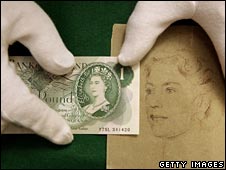 I have been remembering when I first grasped the true value of money. I was eight. My father, in one of his rare flush periods, put into my little paw a penny coin. But this one didn't have the face of the new queen on it. In fact it was hard to make out a face at all.
I have been remembering when I first grasped the true value of money. I was eight. My father, in one of his rare flush periods, put into my little paw a penny coin. But this one didn't have the face of the new queen on it. In fact it was hard to make out a face at all.
Within the sliver-thin disc, worn smooth and shiny by great age, was a left-facing silhouette profile of a lighter shade of copper, raised just slightly from its dark base. I could make out a naked neck, a beaky bird-like nose, and tall brow from which hair had been swept back and tied in a ribboned bun.
It was the image of the young Queen Victoria, Dei Gratia, and the date stamped on the penny was 1859.
I am, you may be disappointed to hear, no numismatist. I can barely say the word. But coins, for me, have always had this romantically augmented richness. I grieved bitterly in 1972 when the pound became something constituted from 100 boring pence.
I had always liked the mere fact of a ha'penny; the sweetly poetic touch of putting the jenny wren - the smallest British bird - on the smallest coin, the humble farthing. I especially loved the threepenny bit for its dodecagonal - 12-sided - weirdness, its brass and nickel sallow yellow gleam and the crowned portcullis on its back.
I loved their nicknames. The long gone Victorian fourpenny piece had been known as a "joey"; our "tanners" - sixpence - seemed a chirpy thing, the right size for a small shot of merriment like sticking it deep in the depths of a Christmas pudding.
The thing about coins is their seeming defiance of monetary transience. Even when no longer legal tender, their reassuringly jingling durability remains.
It's all in the mind, I know, but not just in my mind. Ever since paper currencies were invented - not to mention stock certificates and bonds, junky or otherwise - lightness and perishability have been constant themes of monetary moralists, and all the promising by central banks and treasuries printed on the notes to "pay the bearer" has made no difference to those anxieties and suspicions.
Philip Mernick adds:
Interesting article although highly unlikely that he would have had a "sliver thin" penny dated 1859. 1859 pennies were thickish copper and didn't circulate long enough to get "sliver thin" as they were gradually withdrawn after the bronze "bun penny" appeared in 1860. The "bun" pennies did, however, remain in circulation until the UK went decimal on 15th February 1971. By that time they were very thin and the dates would have been difficult to read.
To read the complete article, see: When money is just an illusion (news.bbc.co.uk/2/hi/uk_news/magazine/8654411.stm)
NEW YORK TIMES ARTICLE COMPARING THE OLD AND NEW $100S
Last week, the Treasury Department introduced its new $100 bill, a redesign intended to frustrate high-tech counterfeiters when it goes into circulation Feb. 10.
The $100 bill, a favorite of forgers, is not only the highest-value denomination in general circulation, but also the most widely distributed and most counterfeited outside the United States.
Perhaps anticipating the criticism that accompanies anything new, a special-effects-laden “unveiling” video released by Treasury reveals a sensuously undulating $100 note as it enumerates the bill's security features.
But how does the look of the new $100 bill compare with its predecessor?
BENJAMIN FRANKLIN
Old: The off-center oval is too large and
unbalanced.
New: Adding Franklin's shoulders and removing
the background avoids the unbalanced look.
COLOR
Old: The green is elegantly traditional.
New: The shifting-colored hues gives the bill a
modern aesthetic.
BACKGROUND AND WATERMARKS
Old: Subtle.
New: Too many and they look like smudges.
COMPOSITION
Old: Comparatively simple, yet the seals, type and other
graphic elements seem disjointed and appear random.
New: Many obtrusive graphic elements, including the
security bars and watermarks, yet curiously the overall
design is more unified.
SECURITY RIBBON AND THREAD
Old: Not there.
New: Necessarily obtrusive. Gives the
impression of a credit card or money order.
FILIGREE (THE BORDER AROUND THE BILL)
Old: Classic application gives the note an
official banknote aesthetic.
New: Reductivist and minimal application
lightens the note and implies modernity but
could unwittingly suggest deflation.
NUMERALS
Old: Well positioned in relation to filigree.
New: Smaller is better, but the numbers are not
well integrated into the filigree, making them
look like an afterthought.
BELL IN INKWELL (IN ORANGE)
Old: Not there.
New: Playful and unnecessary.
DENOMINATION IN WORDS
Old: Elegantly composed as part of the filigree.
New: Squeezed too close to Franklin's forehead.
SERIAL NUMBERS
Old: Clear and unencumbered.
New: Harder to read against watermarks and
somewhat less legible for players of liar's poker.
To read the complete article, see: Anatomy of a Benjamin (www.nytimes.com/2010/04/25/weekinreview/25considered.html)
MAN CAUGHT PAYING COUNTY FINE WITH COUNTERFEIT NOTE
The Scott County Sheriff's Department is reporting the arrest of a man who paid a fine partly with counterfeit money.
Authorities say 35-year-old Yancy Cochran went to the Scott County Court clerk's office on April 21. To pay the fine, Cochran used $10 and $50 bills, which a clerk checked for authenticity. It was determined one of the $50 bills was counterfeit.
The court clerk's office notified sheriff's investigators, who inspected the bill and found the original bill, bearing the same serial number, in the stack of currency. Authorities didn't say why Scott was paying a fine.
Cochran is charged with one count of forgery. After a court appearance Thursday, he was being held in lieu of $500 cash only bond in the Scott County Jail.
To read the complete article, see: Man accusing of paying fine partly with counterfeit money (www.wqad.com/news/sns-ap-ia--counterfeitcase,0,1538544.story)
FEATURED WEB SITE: THE E-SYLUM ARCHIVE
This week's Featured Web Site is our own E-Sylum archive. Part of the Numismatic Bibliomania Society web site, the E-Sylum archive stores a copy of every single issue of The E-Sylum from our very first issue to date.

This year's issues are here:
Thanks to webmaster Bruce Perdue, new issues go up on the site pretty fast – usually sometime Monday morning. There is a Google search box on the page, enabling visitors to search for words and phrases anywhere in The E-Sylum. The archive is a great place to go whenever there is a problem reading your weekly email version of The E-Sylum.
www.coinbooks.org/club_nbs_esylum_archive.html

